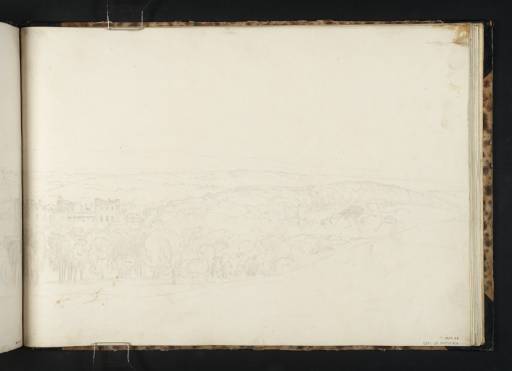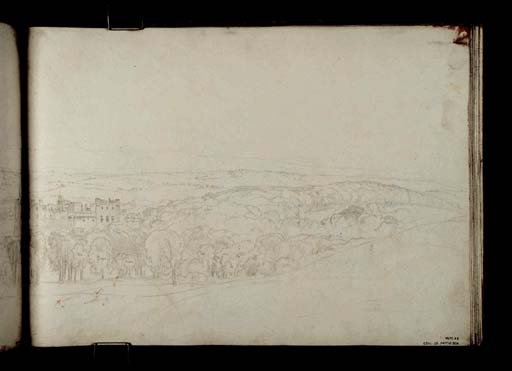Joseph Mallord William Turner Raby Castle and Park from the North 1817
Image 1 of 2
Joseph Mallord William Turner,
Raby Castle and Park from the North
1817
Joseph Mallord William Turner 1775–1851
Folio 17 Verso:
Raby Castle and Park from the North 1817
D12297
Turner Bequest CLVI 22
Turner Bequest CLVI 22
Pencil on white wove paper, 232 x 328 mm
Inscribed by Turner in pencil ‘Red’, ‘Green’, ‘Brown’, ‘yellow’ (some repeated) on various trees across the centre, and ‘3’ towards centre right
Stamped in black ‘CLVI 22’ bottom right
Inscribed by Edwin Fagg in pencil ‘CLVI.22 part of 21a’ bottom right
Inscribed by Turner in pencil ‘Red’, ‘Green’, ‘Brown’, ‘yellow’ (some repeated) on various trees across the centre, and ‘3’ towards centre right
Stamped in black ‘CLVI 22’ bottom right
Inscribed by Edwin Fagg in pencil ‘CLVI.22 part of 21a’ bottom right
Accepted by the nation as part of the Turner Bequest 1856
Exhibition history
1878
Oxford Loan Collection, University Galleries, Oxford 1878–1909 or later (88; renumbered 65).
References
1904
E.T. Cook and Alexander Wedderburn eds., Library Edition: The Works of John Ruskin: Volume XIII: Turner: The Harbours of England; Catalogues and Notes, London 1904, p.563 (Oxford loans catalogue, 1878) no.65, as ‘Raby’.
1909
A.J. Finberg, A Complete Inventory of the Drawings of the Turner Bequest, London 1909, vol.I, p.448, CLVI 22, as ‘Raby Castle’.
1984
Martin Butlin and Evelyn Joll, The Paintings of J.M.W. Turner, revised ed., New Haven and London 1984, p.101 under no.136.
The north side of the castle is seen from a little east of due north, with Mount Raskelf on the left, the Kitchen Tower with its high chimney in the middle, and Clifford’s Tower on the right, with the twin turrets of the detached gatehouse in front of it. There is a view from the same angle, but much closer and from a lower elevation, on folio 25 verso (D12283; CLVI 14). The panoramic view across country to the south continues to the left on folio 18 recto opposite (D12296; CLVI 21a), where Bulmer’s Tower, at the south-eastern corner of the castle also appears. There is a further continuation of trees to the left on folio 19 recto (D12278; CLVI 11a).
Butlin and Joll have noted this and folio 18 recto as forming ‘the most detailed and exact study’1 for the oil painting Raby Castle, the Seat of the Earl of Darlington, exhibited at the Royal Academy in 1818 (Walters Art Gallery, Baltimore).2 The general lines of the terrain and the profile of the castle are followed very carefully in the painting, and many of the trees in this drawing are also transcribed closely. For the contre-jour effect of sun through high cloud from the south, Turner resorted to a similar view, from lower and slightly further to the west, on folios 21 recto–20 verso (D12300, D12301; CLVI 23a–24), which he partly touched in watercolour to show the castle in shadow and light filtering through the foliage.
The foreground of the painting is deeper and the slope to the right rolling to provide an arena for the fox hunt which Turner placed there in reference to his patron’s sporting enthusiasms (see the introduction to the tour).
Technical notes:
The inscription ‘CLVI.22 part of 21a’ correctly links this half of the composition to the opposite page. The hand matches that of similar inscriptions on folios 15 verso and 16 recto (D12294, D12307; Turner Bequest CLVI 20, 27), which are initialled ‘EF’, signifying Edwin Fagg, the Tate Gallery’s Official Lecturer, who had supervised immediate restoration work on Turner Bequest works and compiled a report of the damage caused to them following the 1928 Tate flood.1
There is a brown stain at the top right corner, which has bled through from the other side of the leaf D12298; Turner Bequest CLVI 22a). Presumably this dates from the mounting of the page for display.
Matthew Imms
February 2010
How to cite
Matthew Imms, ‘Raby Castle and Park from the North 1817 by Joseph Mallord William Turner’, catalogue entry, February 2010, in David Blayney Brown (ed.), J.M.W. Turner: Sketchbooks, Drawings and Watercolours, Tate Research Publication, December 2012, https://www


